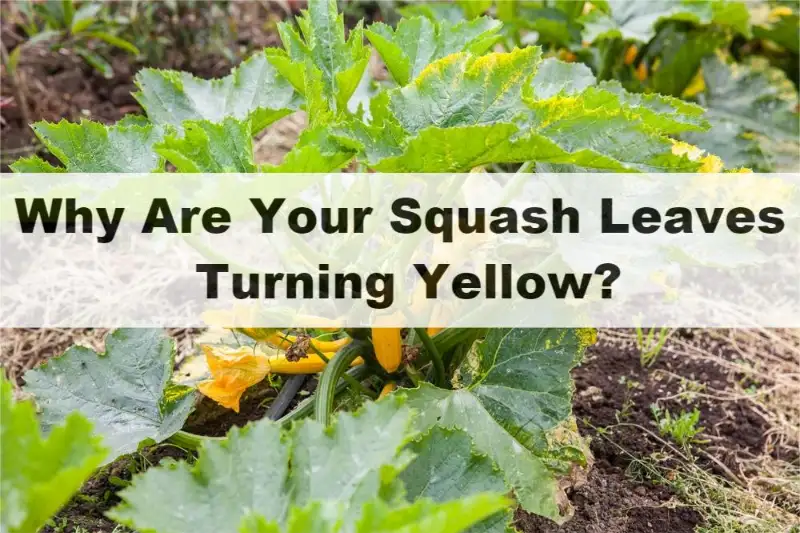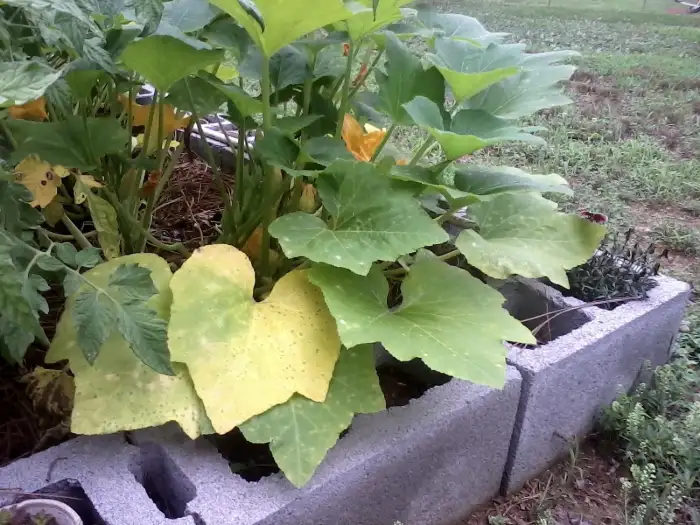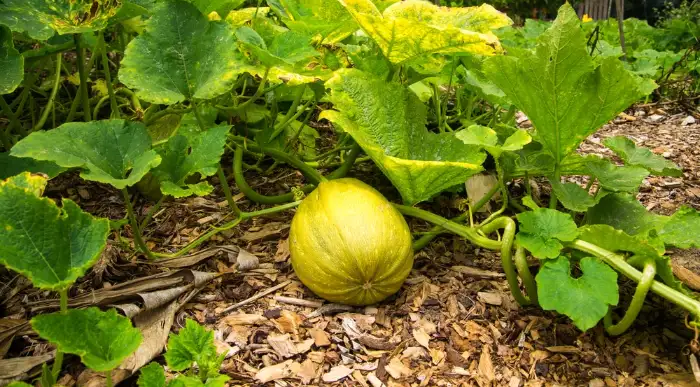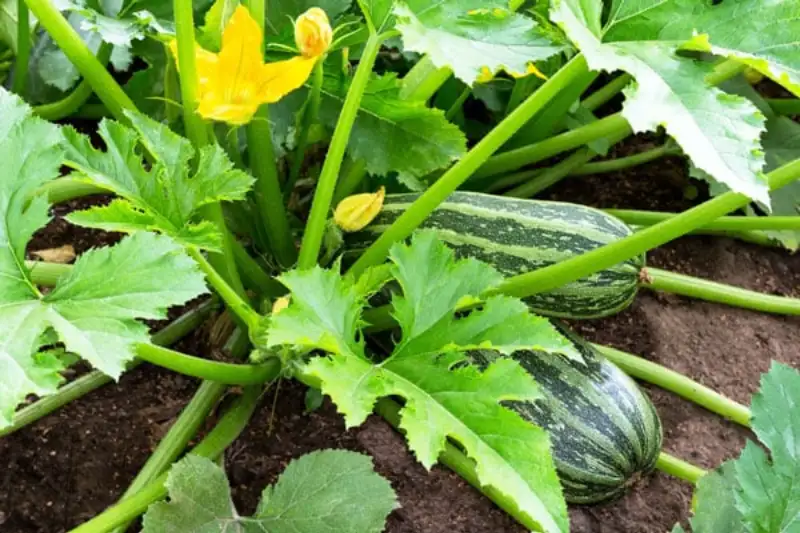WHY ARE MY SQUASH LEAVES TURNING YELLOW? This question is all too familiar to gardeners and vegetable growers. It’s enough to pull your hair out, but fortunately, this article is here to HELP you!
You can trust us to give you the information needed so that your SQUASH PLANTS look healthy again. Just think of us as the “squash whisperers” Hahaha!
We are expert GARDENERS! Our goal is to provide a comprehensive guide for anyone who experiences this problem. We have something for you, whether you are an AMATEUR gardener or an EXPERIENCED farmer.
Our clear explanations give you confidence when tending to your next crop of SQUASH! Never worry about SQUASH LEAVES TURNING YELLOW again.
It could be more fun than a real-life game of CLUE. So get your MAGNIFYING GLASS, and let’s get to the bottom of this!

The Reasons for Squash Leaves Turning Yellow

Squash plant leaves can become yellowed and stunted. This is not only unappealing but can lead to decreased yields. So what are the reasons for squash leaves turning yellow?
Pests:
Squash bugs and spider mites feed on SQUASH PLANTS. They suck the sap from their leaves and cause them to TURN YELLOW. It’s like a SQUASH BUG decided to have an all-you-can-eat buffet, and your plant was the main course!
Other symptoms may follow, such as wilting or discoloration of the affected areas.
Diseases:
Diseases also affect the leaf color of your SQUASH. A typical example is Zucchini Yellow Mosaic Virus (ZYMV). That name is a mouthful, right? It is an INFECTIOUS VIRUS that can cause squash leaves to TURN YELLOW.
Infected PLANTS may have patches of discolored foliage on both sides of the leaf. OTHERS may experience stunted growth due to nutrient deficiencies caused by this VIRUS.
Nutrient Deficiency:
Iron deficiency is a very common cause of yellowing leaves in SQUASH PLANTS. When iron levels drop too low, CHLOROPHYLL PRODUCTION slows down. This causes leaves to appear pale green or even yellowish-white in color.
Iron deficiency in squash plants is like having money in the bank but not being able to withdraw any of it. The ‘bank’ (the soil) has plenty of iron for the plant. However, the PLANT cannot access any of it for some reason, so it leaves TURN YELLOW instead!
Environmental Stressors:
Extreme temperatures (both high heat and cold) can cause STRESS on SQUASH PLANTS. Squash are just like people-extreme temperatures make them stressed. This leads to LEAF DISCOLORATION due solely to ENVIRONMENTAL FACTORS.
Why Is Squash Plant Turning Yellow?

Nutrient deficiency is one of the most common reasons squash leaves turn YELLOW. This could be due to the soil not having sufficient NUTRIENTS. Or the LACK of certain MINERALS that are ESSENTIAL for healthy growth. So your plants may be HUNGRY and asking, ‘where’s my dinner?’
In addition, vine borers also cause the YELLOWING of leaves and STEMS. They feed on SAP from within the plant’s stem. Vine borers are like pesky siblings who take all the FOOD in the house and leave nothing for anyone else!
Fusarium Wilt is another fungal disease that affects squash plants. It can cause discoloration of foliage and fruit, with leaves turning YELLOW or BROWN. So it looks like your plant has a bad case of Jaundice!
Mosaic viruses lead to yellow spots or mottling on squash leaves. It can also lead to their overall yellowing.
As these viruses attack all parts of the plant, some parts may be more affected than others. This may result in an uneven yellowing pattern across the entire plant.
Leaf veins are often one of the first areas to show signs of DAMAGE. This VIRUS causes them to become LIGHTER in color than regular foliage.
Think highlighting done wrong at home by an amateur hairdresser! It eventually leads to an overall lighting effect throughout your entire squash plant.
Finally, another common reason squash plants may turn YELLOW is when planted in clay soil. Drainage issues lead to soggy roots, which can ROT the plant over time. Drowning is no fun, even for your squash.
How to Fix Leaf Yellowing on Squash Plants?

Fixing leaf yellowing on SQUASH PLANTS can be a tricky task. The solutions should target the ROOT CAUSE of the problem. Below are tips that can help you fix yellowing leaves on squash plants with squashy success:
1. FERTILIZE:
Squash plants require regular FERTILIZATION to stay healthy and prevent NUTRIENT DEFICIENCIES. Otherwise, they’ll start looking like that one kid in high school who always had too little to EAT.
This often manifests as yellowed leaves. Apply an all-purpose FERTILIZER to your squash plants every 6-8 weeks. You can also use one specifically designed for VEGETABLES. Adding ORGANIC matter is also recommended.
2. IRON CHELATES:
Iron chelates are minerals used in plant nutrition. Give your little veggies their DAILY DOSE of vitamins. You are ADDING it to ensure IRON availability. Adding iron chelates to your squash plants will prevent LEAF yellowing.
3. SUNLIGHT & AIR CIRCULATION:
Squash plants need DIRECT SUNLIGHT for at least 6 hours per day. So, ensure your plant is getting plenty of SUN EXPOSURE daily.
Also, ensure there’s good AIR CIRCULATION around your plant. Do this by providing adequate SPACING between other garden beds or houseplants nearby.
4. CUT & DISCARD STEMS:
If you notice any STEMS that have turned completely YELLOW or BROWN, cut them off. Don’t fret too much. It probably won’t feel anything since vegetables don’t have nerves… yet! Then, DISCARD them away from other healthy STEMS to prevent DISEASE SPREAD. Safety first, ya know?
5. DRAIN the SOIL:
Make sure the soil around your squash plants is DRAINING WELL. Also, check for and REMOVE CLAY. If there is clay soil in our GARDEN, add ORGANIC MATTER or PEAT MOSS. This IMPROVES DRAINAGE and AERATION around your plant’s roots.
6. PEST CONTROL:
Check your plant regularly for signs of PESTS such as APHIDS and MEALYBUGS. Think Sherlock Holmes with his magnifying glass but looking for BUGS instead! If you spot any, use INSECTICIDAL SOAP to remove them and prevent yellowing squash leaves.
7. FUNGICIDES:
Be on the lookout for FUNGAL DISEASES such as POWDERY MILDEW, DOWNY MILDEW, and FUSARIUM. If you notice any sign, apply an APPROPRIATE FUNGICIDE to prevent further spread. Feel free to declare “GERMS AWAY!”
Care Tips for Squash Plants

Although squash plants are lovely, they can be tricky to maintain. Here are some tips for keeping your SQUASH plants healthy and happy:
1. Drainage
Plant squash in WELL-DRAINED soil with plenty of ORGANIC matter. Could you not feed them junk food all the time? Hahaha. So make sure the soil you choose is rich in iron chelates, or use a fertilizer specific to SQUASH plants.
Suggested reading: Water Pumpkin Properly: Detailed Guide
2. Pests
Keep an eye on PESTS that may try to feed on your squash leaves or stems. If you see any signs of damage, take action immediately by removing the affected parts. Then apply an appropriate insecticide if needed. Nothing ruins dinners faster than unwanted ‘squash-eaters!’
3. Moisture
Watch the MOISTURE levels in the soil around your plant. Too much water can cause yellowing leaves. Also, too little water can stunt growth and even kill the PLANT! Make sure your squashes get just enough water without getting soggy feet!
4. Nutrients
Feed your SQUASHES with certain NUTRIENTS. These could include nitrogen, phosphorus, potassium, and magnesium. Do it throughout the growing season for the best results. You may also want to invest in a NUTRIENT SPRAY.
Go for one specifically designed for VEGETABLES, like squash. It will provide all the right nutrients directly onto your plant’s foliage!
5. Pruning
Pay attention to how much FRUIT each vine is producing. If one isn’t producing much SQUASH, it might be time for some PRUNING! Prune away extra stems from overcrowded vines.
This gives each stem enough sun exposure and nutrition from its root system. This should help encourage more FRUIT production!
6. PH
Track SOIL PH. Squash prefers a lower soil PH; around 6.0-6.5 is ideal! You can test your soil’s PH with an affordable testing kit and ADJUST it if necessary. Otherwise, you’ll have ‘phunny’ looking SQUASH plants! Hahaha
7. Sunlight
Give your SQUASH plenty of SUNLIGHT. Squash are SUNLIGHT lovers and need at least 6-8 hours of sunlight daily to produce healthy fruit. Make sure your plants are planted in an area that receives DIRECT SUNLIGHT most of the day! You don’t want ‘shady’ looking squashes! Hahaha!
FAQs about Squash Leaves Turning Yellow
1. Should you cut yellow leaves off squash plant?
Yes, we recommend cutting off squash leaves that have turned yellow. Removing the affected leaves can help improve the overall health of the plant. It will prevent further damage.
2. Should you water squash plants daily?
No, daily watering of squash plants is not necessary. Proper irrigation depends on the soil type, rainfall, and other factors. If the soil is sandy, more frequent watering may be needed. If you suspect a watering problem, monitor the leaves for signs such as wilting or yellowing.
3. Does squash need a lot of fertilizer?
No, squash does not require a lot of fertilizer. Squash generally requires a small amount of fertilizer in the form of compost or manure. This helps promote healthy growth and fruit production.
It is important to use fertilizers sparingly. Applying too much can have negative impacts on soil health and plant vigor.
4. Do coffee grounds help squash plants?
Yes, using coffee grounds can be advantageous for squash plants. It can provide a source of nitrogen which boosts the growth of healthy leaves and stems. Additionally, it may attract beneficial insects that help to protect the plant from pests.
Also, coffee grounds help keep moisture in the soil. This improves soil structure, creating ideal conditions for roots to absorb nutrients efficiently.
What’s Next
We told you why squash leaves turn yellow and how to fix it. The next step is to focus on the care of your squash plants. You learned some tips for preventing yellowing leaves and maintaining healthy squash plants.
Fertilize regularly, provide adequate sunlight and air circulation, and eliminate pests. Also, test the soil for nutrient deficiencies like low iron levels. These steps will help you ensure that your squash plants remain in top condition!
If you’re experiencing “squash leaves turning yellow,” don’t worry. AsterGardening has the answers! Our article covers what you need to know about the causes of yellowing and how to fix them.
We also provide a wealth of information on gardening. Whether you are a beginner or a professional, we’ll help you keep your garden healthy and vibrant. Discover solutions now, and get your green thumb back on track!
